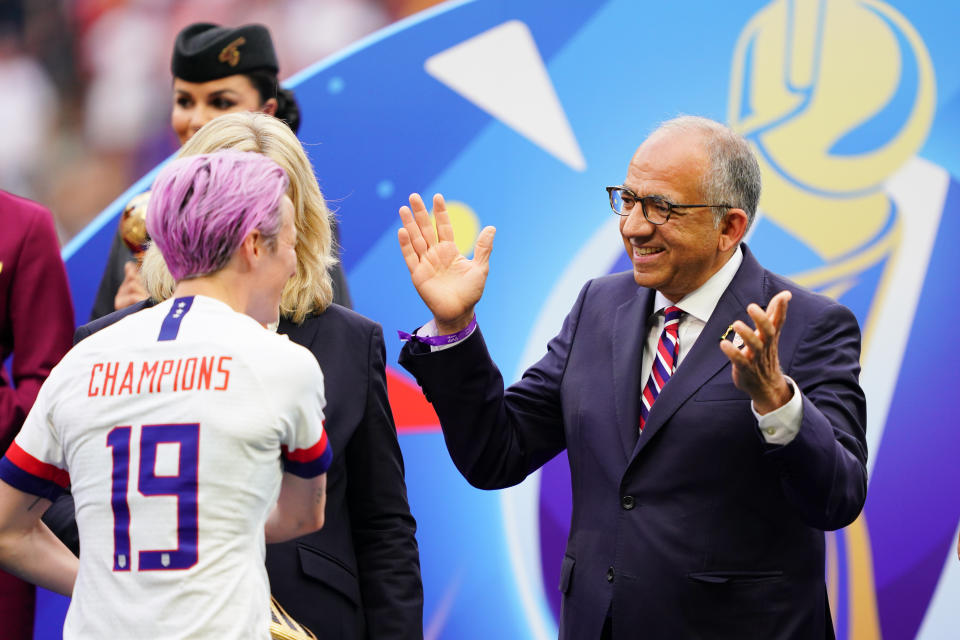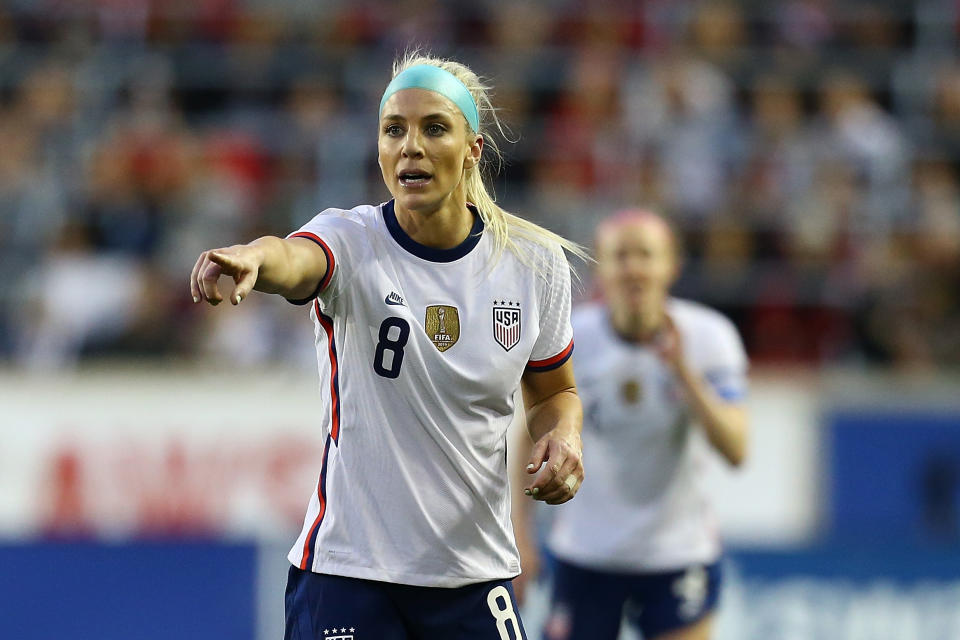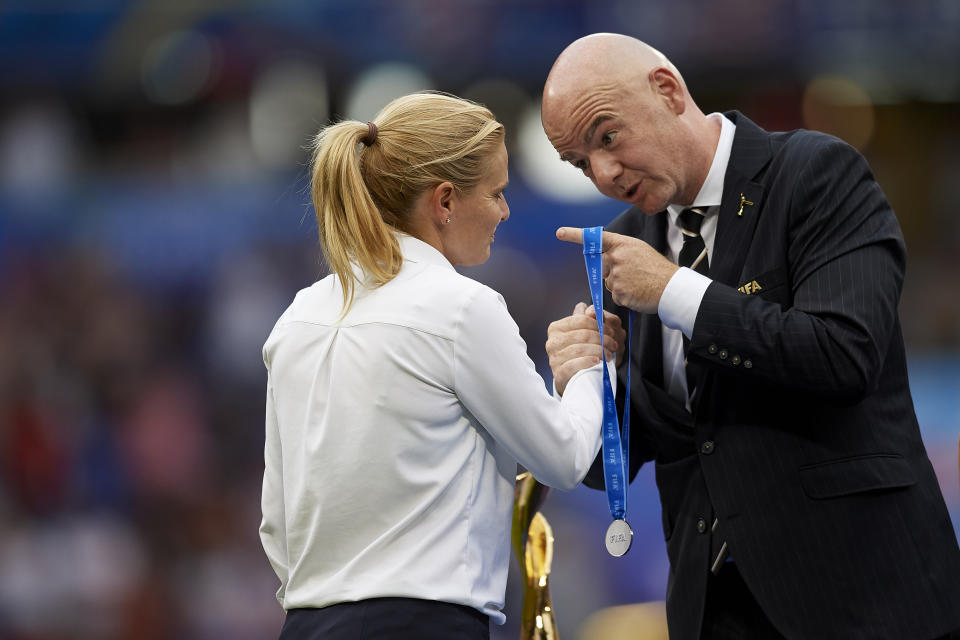What would equal pay for the USWNT look like?

What is equal pay in international soccer?
If there were an easy answer to that question, the lawsuit between the U.S. Soccer Federation and the U.S. women’s national team would’ve been settled by now. Instead, with increasingly harsh rhetoric flying around, the issue seems headed for a trial in May.
The concept of “equal pay” is pretty simple: equal pay for equal work. In most fields, it’s not any more complicated than that.
But for two national soccer teams that want different things, play different schedules, are eligible for different tournaments and receive different prize money, the details become much harder to pin down.
Why there’s not already ‘equal pay’
The USWNT and the USMNT have never been paid equally. That’s because, with good reason, the U.S. men’s and women’s teams are paid through different compensation models.
While the USMNT is paid based on call-ups, game appearances and win bonuses, most USWNT players get paid salaries. That’s what the separate collective bargaining units for the USWNT and the USMNT fought for.
The women prioritized stability, while the men opted for a bonus structure that was more of a gamble for each player.
In the USWNT’s collective bargaining agreement, 17 players this year are on contracts to earn $100,000 salaries. The players without contracts earn $3,500 per game, plus small fees for being called into camp. All USWNT players, on contract or not, earn win bonuses up to $8,500 per friendly and, on the other end of the spectrum, up to $110,000 each for winning a World Cup.
None of the USMNT players, meanwhile, earn salaries. Instead, they can earn bonuses up to $17,625 per friendly and, on the opposite end of the spectrum, more than $1 million each if they win a World Cup.
The reason the USWNT prioritized a guaranteed income is beyond the players’ control and has more to do with the world we live in.
Players on the USMNT make their livings playing club soccer because there is a long-established and well-resourced infrastructure around the men’s game.
Michael Bradley, for instance, was the top-paid USMNT player over a six-year period from 2014 to 2019, and he made around $1 million total on national team duty in that time. Toronto FC, meanwhile, paid Bradley more than $6 million each year, rendering the USMNT a tiny fraction of his overall income.
The opportunities to make a living in women’s club soccer, by comparison, have been virtually non-existent throughout most of the USWNT’s history.
Women’s soccer was banned around the world up until relatively recently. In England, it was effectively banned until 1971. In Brazil, it was banned until around 1981. In Germany, women were finally allowed to play in 1970. It’s no surprise that the investment in the women’s game lags so far behind when women’s soccer was illegal for so long.
When the USWNT’s current pay structure of guaranteed salaries was designed in 2005 and U.S. Soccer agreed to it, there was no league for the women to play in. If U.S. Soccer didn’t pay them salaries, many players would’ve had to quit.
“I think it’s OK that the compensation structures are a little bit different,” Megan Rapinoe said on the Today Show last year. “Our realities are a little bit different.”
Indeed, the different payment structure for the USWNT — a model that is not “equal pay” — has been a historical necessity rather than some sort of benefit.
So, what would equal pay look like?
Now that it’s established how and why the USWNT and USMNT are paid differently, the question becomes how can it be made equal?
One looming problem is that the U.S. men and women have different four-year cycles, during which they play a different number of games and compete in different tournaments, which means male and female players will never qualify for the same income in a calendar year.
Equal pay would have to refer to an equal pay rate, which is something the USWNT argues for in its legal documents. U.S. Soccer claims it has actually paid the women more than it has paid the men, but the USWNT argues that’s only because the women worked more and the USWNT’s pay rate is lower.
But finding an equal pay rate for both teams shouldn’t be that difficult.
While USWNT players earn guaranteed payment through their $100,000 salaries, the men do get some guaranteed income, just in a different form. Because USMNT players earn $5,000 per game appearance, in a 20-game year, U.S. Soccer would be paying the equivalent of $100,000 salaries anyway.
The question is whether USWNT players would be willing to give up salaries and move to a stipend per call-up. It seems like they might be.

Sources have told Yahoo Sports that, in negotiations for the team’s latest CBA in 2017, the federation pushed to eliminate guaranteed salaries entirely but USWNT players refused. The USWNT did, however, agree to start moving their compensation in that direction, drastically reducing the number of contracted players from 24 in the team’s previous CBA to 16 by 2021.
The long-term goal, according to the players, is to create a compensation model where the USWNT’s rosters can be more flexible and, instead of locking in a core group that is guaranteed to make the team, every player has a chance to earn a spot based on form.
Once there’s an equal base rate, the friendly win bonuses could be brought in line as well.
Sunil Gulati, the former president of U.S. Soccer, has admitted the men have never been as successful as the women, and that was partly why U.S. Soccer offered larger financial incentives for the USMNT to win. But viewed in another way, the incentive argument penalizes the USWNT for its own success.
It was probably also easy for U.S. Soccer to offer larger bonuses for the men since it’s less likely the USMNT would win any given game. But clearly these incentives don’t work because the men still keep losing, so there’s no reason to keep them in place.
The USMNT should happily agree to this equal pay structure; the team’s union has talked a big game about U.S. Soccer not treating the women fairly, and this is the chance for the USMNT union to prove that was sincere.
One more thing: While U.S. Soccer has tried to bundle NWSL salaries with USWNT compensation in its legal arguments, it seems that the people working at U.S. Soccer know that’s not really fair. NWSL salaries, assuming they continue to exist in the future, should remain separate from USWNT compensation.
FIFA: The elephant in the room
The legal teams for each side of the ongoing lawsuit have filed hundreds of documents arguing their stances, and one major roadblock to equal pay has emerged: FIFA prize money.
FIFA, the governing body of world soccer, pays the winner of the men’s World Cup 10 times what it pays the winner of the Women’s World Cup.
This is such a problem that when the union that jointly bargains for both the men’s and women’s national teams in Australia created an equal pay deal, it just ignored FIFA prize money altogether. The Socceroos and the Matildas will be paid equally to the cent — except for when they compete in FIFA events.
The USWNT only earned $2 million for winning the 2015 Women’s World Cup and $4 million for winning the 2019 Women’s World Cup. If the USWNT were men, however, they would’ve earned $35 million and $38 million, respectively.
To be clear, FIFA does not pay the men more based on revenue or TV ratings or attendance or any other metric people like to argue. The men’s World Cup does not bring in more revenue than the Women’s World Cup, and anyone who argues otherwise isn’t using real information.
FIFA has a well-documented history of sexism, and has never given an explanation for why the prize money for the men’s World Cup is so much larger, other than the fact the men’s tournament has existed longer, which is an odd argument since it was FIFA’s choice when to start the Women’s World Cup.
Ideally, the USWNT would just sue FIFA — and maybe they should — but instead the players have sued U.S. Soccer, and they want U.S. Soccer to write a check for $66 million in back pay, based largely on the shortfall in FIFA prize money.

That seems like a non-starter. As U.S. Soccer president Carlos Cordeiro said in an open letter over the weekend: “It is not reasonable or fiscally sound for U.S. Soccer to make up the gap. It would seriously impair our ability to support our mission.”
It’s a tough sell for the USWNT. Why should it be U.S. Soccer’s burden to undo FIFA’s sexist policies?
But U.S. Soccer, in its contracts with the USMNT and USWNT, offers bonuses based on how well each team does in the World Cup. The bonuses are not explicitly tied to the FIFA prize money, although U.S. Soccer argues they are in the lawsuit.
Nowhere in the USMNT’s CBA, for instance, does it say the men will earn bonuses as a percentage of FIFA prize money. Instead, the USMNT can earn bonuses for achievements seemingly divorced from FIFA’s pot, like $218,750 per point earned during the group stage of a World Cup.
So since the World Cup bonuses aren’t an exact transfer of FIFA prize money anyway, and since the USMNT is unlikely to advance very far in the tournament, U.S. Soccer should cap the maximum bonus the men can earn, and pay the women a bit more if they win.
Based on the previous cycle, a figure of around $8 million or so could make sense as the maximum for both teams. That would double the prize money if the USWNT won, and it would assume that the round of 16 is probably the best the USMNT can do anyway. The prize money for reaching the round of 16 in 2018 was $12 million, so U.S. Soccer could even triple the USWNT’s winnings.
The USMNT should agree to this because, well, they don’t have much leverage.
They just failed to even qualify for Russia in 2018, and can’t argue that U.S. Soccer’s compensation is essential to their ability to make a living playing soccer like the USWNT can. Also, since the USMNT will probably never win a World Cup anyway, fighting for more of FIFA’s prize money would be like fighting for Monopoly money.
On the off-chance that the men exceed expectations and advance even further, then U.S. Soccer gets a bunch of money it could put toward youth development or set aside for the next time the USWNT wins a World Cup.
The devil is always in the details, and this would require U.S. Soccer to renegotiate new CBAs with both the men’s and women’s teams at the same time. But if equal pay is the goal, figuring out a path forward is possible.
After all, U.S. Soccer could write a $66 million check, as the USWNT has asked for, but then nothing would be solved and U.S. Soccer could be sued for the same reasons again someday. The federation has to figure this out, and if the USWNT really believes their contract is unfair, they should be happy to help.
Caitlin Murray is a contributor to Yahoo Sports and her book about the U.S. women’s national team, The National Team: The Inside Story of the Women Who Changed Soccer, is out now. Follow her on Twitter @caitlinmurr.
More from Yahoo Sports:
